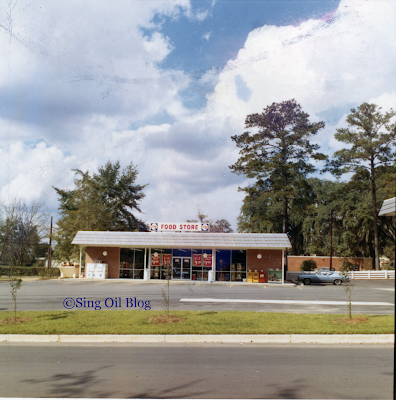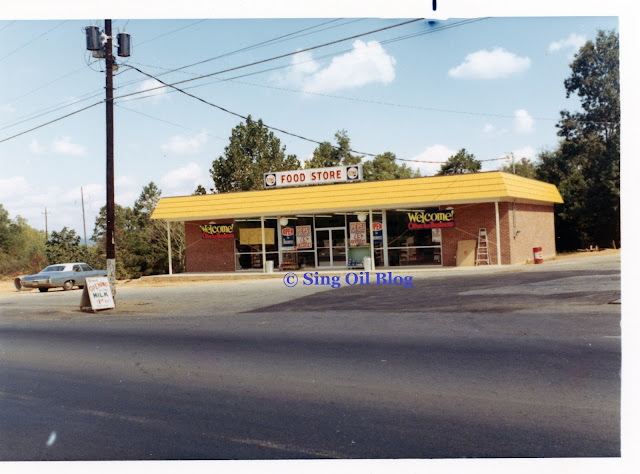Station Architecture
Throughout its history developing convenience stores, Sing Oil Company utilized several styles of station architecture. According to a 1990 article in the Tallahassee Democrat, Sing sold more than 60 million gallons of petroleum products resulting in annual sales of $30 million. Sing sold 54 stations to Amoco: 30 in Georgia, 15 in Florida, 7 in Mississippi, and 1 in Louisiana & Alabama. Sing's largest metro market was Tallahassee, FL with 12 stations.
1960s Stop N' Shop
This was Sing's first convenience store - gas station combo design and was implemented in the second half of the 1960's. Only a few of these stores were built before the similar '70s style was adopted, and all were subsequently updated to match the exterior of the 1970's format. When constructed, the convenience store featured a backlit awning and no columns out front. These stores also had a sconce mounted to the brick walls on either side of the front glazing.
1960s Stop N' Shop with Brick Columns
As a derivation of the Stop N' Shop model, this format featured a similar interior to the earlier stores but upgraded the exterior to have a shingled awning supported by columns. These stores would have still utilized the Stop N' Shop branding on exterior signage. In contrast to the later stores, these are differentiated by one brick column on each corner of awning, in contrast to the wood ones in the center.
- 1965 | Columbus #3 | Shopping Plaza
- 1968 | Tallahassee #3
- 1969 | Tallahassee #4 | Deli | Shopping Plaza
- 1972 | Winters Chapel^
1970s Rectangle
Sing's most common store design, this format further iterated the Stop N' Shop model to include a shingled awning over the front of the store supported by wood columns. The interior of these stores would have closely resembled the previous store designs. Sing would begin to modify this model in the late 1970's, when it also began to experiment with a new convenience store format. These stores were typically 2,800-3,000 sq ft when built.
With Front Columns:- 1969 | LaGrange #2 | Deli
1969 | Tallahassee #5 (Food Store Only)^- 197x | Thomaston
- 1970 | Columbus #4 | Deli
- 1970 | Perry #1 | Deli
- 1970 | Rockbridge (Shop on Right)
- 1971 | Columbus #5
- 1971 | Thomasville #5
- 1972 | Tallahassee #7 | Deli (Expanded)
- 1972 | Knoxville #1^
1972 | Knoxville #2^- 1973 | Memorial Drive (Shop on Right)
- 1973 | Six Flags
197x | Redan- 1975 | Tallahassee #8 | Sing Fast Food Mall
- 1975 | Tallahassee #9
- 1975 | Jacksonville #1^
- 1975 | Jacksonville #2 (Food Store Only)^
1976? | Powder Springs (Brick Columns) (1972-1976)1977 | Tallahassee #10 | True Value | Deli (Expanded)- 1977 | Columbus #6
- 1978 | Carrollton | Laundry
Small Format Square
The small format square stations were Sing's first attempt at a unique station design in over 10 years. Typically located on the corner of an intersection, these stores had two entrances and were often aligned with one door facing each road. The stores originally had the cash registered centered between the two doors and a gas payment window directly behind it. Drink coolers lined one of the rear walls of the store and a counter with the soft drink fountain flanked the other. None of these stores were built with delicatessens, but several were retrofitted to add hot food. This station format was used for about six years, until it was replaced by its larger cousin below. These stores were approximately 2,800 sq ft when built.
1977 | Sandy Plains*- 1978 | Albany #7 | Deli
- 1978 | Albany #8
- 1979 | Columbus #7
- 1979 | Columbus #8
1979 | Trickum (Shop on Right, Self-Carwash Behind)- 1979 | Jackson #2 | Deli
- 1980 | Port St. Joe | Deli
- 1981 | Jackson #3 | Deli
- 1983 | LaGrange #4
Large Format Square
The large format square stores are a modified, expanded version of the late '70s square model. These stations combined the two entrances into one that was centrally located between the two façades. To the left of the door was the gasoline payment window, directly behind which was the cashier stand. Adjacent to the cashier was the deli, which I believe was included in all implementations of these stores. The aisles were aligned perpendicular to the door and drink coolers lined the entire back wall. A small seating area was stationed to the left of the entrance, with the restrooms behind. These stores were approximately 3,600 sq ft when built.
With Upper Cashier Window Bank:
- 1984 | Jackson #4 | Deli
- 1984 | Jackson #5 | Deli
- 1984 | Bradfordville | Deli
- 1984 | Jacksonville #3 | Deli
- 1986 | Moultrie | Deli^
Without Upper Cashier Window Bank:
- 1985 | Laurel | Deli*
- 1985 | Columbia | Deli
- 1985 | Opp^
- 1986 | Enterprise^
- 1986 | Troy^
- 1986 | Tallahassee #12 | Deli
1980s Rectangle

|
| Google Street View - Bogalusa, LA - May 2014 |
Although this was Sing's last station prototype used before the Amoco merger, it is also the one I have the least historical information on. I have not found a single historical picture of one of these station and do not know exactly how they would have looked back in the 1980's. I was lucky enough to find this street view from Bogalusa which shows Sing's 1980's awning (painted red); unfortunately, sheet metal now covers Sing's shingles at this store. These stores were approximately 3,000 - 3,200 sq ft when built and likely would have all included a deli. I have been in two of these stores, and I believe they originally had the cashier counter directly in front of the door, with snacks and drink coolers on the right side of the store and a deli seating area / fountain drink section to the left. Some of the later models of this store include a window on the left side of the building for the seating area.
Without Left Window:
1985 | Tallahassee #11 | Deli- 1985 | Tallahassee #13 | Deli
- 198x | Bogalusa | Deli
With Left Window:
- 1987 | LaGrange #5 | Deli
- 1987 | Tallahassee #14
- 1989 | Jacksonville #4
- 1994 | "Columbus #9"
Miscellaneous
These stores don't quite fit the bill of the categories above, and seem to be one-off iterations for a variety of reasons. In the case of the Perry Travel Center, this store likely would have seen more clones had Sing not merged with Amoco the next year
- 1965 | Thomasville #2 | Dealer Station
- 1971 | Tallahassee #6 | Deli | Sing District Office (Large Format, Spanish Revival)
197x | Jackson #1(Convenience Store under Canopy, built before 1979)1972 | Chamblee-Dunwoody (C-store only)- 1979 | Gadsden
- 1983 | Thomasville #6 (Convenience Store under Canopy)
- 1988 | Gulfport | Deli (Larger Version of Thomasville #6)
- 1989 | Perry #2 | Deli (Travel Center)
Unaffiliated, Post Merger

|
| Google Street View - Tallahassee, FL - April 2011 |
These stores are a rare breed: Sing branded Amoco convenience stores. I have found licensing information that leads me to believe more of these were out there but I couldn't find enough proof to include them here. These stores only appeared in the Tallahassee market during the 1990's and were wiped away by 1999. I really wish I had pictures of these! The most interesting example is Amoco-Sing #5059, shown above, which was a combination McDonald's / convenience store.
Planned, Undeveloped Sites
Although Sing Oil Company had slowed down their expansion efforts during the time leading up to the Amoco merger, they had still purchased parcels of land to develop future convenience stores. The following locations were sold to Amoco as undeveloped or partially developed locations.
- St John's County, FL - Vacant lot
- Hanging Moss, Jackson, MS - Marathon station
- Holder, FL -
- Killearn, Tallahassee, FL
- Columbus #9 - 1980s Rectangle Sing building, Hop-In / Shell station
- Columbus #10 - Circle K station
- Woodville, FL - Circle K station
- Tallahassee #15 (Tharpe St) - Bruster's Ice Cream
- Bradfordville, FL - Land surrounding station
Missing / No Information
Due to Sing's numbering system, I was able to identify the following station that I know existed but I have no information on. I would love to locate it, one day.
- 1969-1982 | LaGrange #3 (Possibly New Franklin Road)
Key:
* denotes imprecise year
^ denotes station sold prior to Amoco merger
"denotes station built after Amoco merger using Sing plans
Italicized Deli indicates opened before September 1985










Comments
Post a Comment